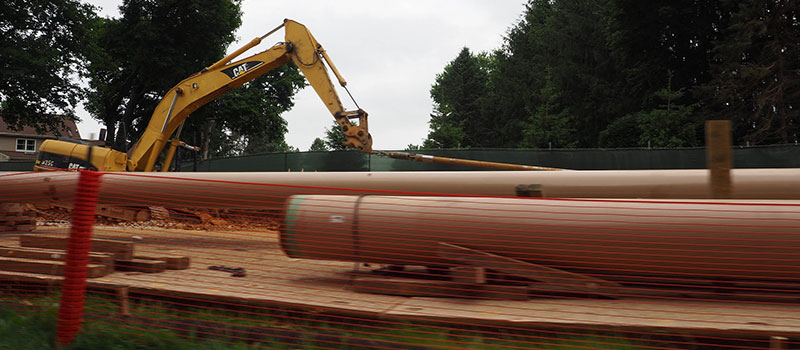The following terms are useful in understanding the engineering and legal terms sued in the planning, construction and repair of pipelines. These definitions were taken from the glossary presented in the Pipelines and Informed Planning Alliance Final Report of Recommended Practices (PIPA), published in November 2010 by the United States Department of Transportation, Pipeline and Hazardous Materials Safety Administration, Office of Pipeline Safety. A list of acronyms are defined below the glossary of terms.
Glossary
Abandoned Pipeline: A transmission pipeline that has been permanently removed from service and left in place.
As-built Drawing: A detailed drawing or set of drawings depicting the actual configuration of installed or constructed facilities.
Backfill: The act of filling in the void in a utility ditch that was created by excavating, usually by replacing the soils that were removed. Also, the material used to fill the ditch.
Building Setback: See "Setback"
Cathodic Protection: The process of arresting corrosion on a buried or submerged metallic structure, by electrically reversing the natural chemical reaction. This includes, but is not limited to, installation of a sacrificial anode bed, use of a rectifier based system, or any combination of these or other similar systems. Wiring is installed between the buried or submerged structure and all anodes and rectifiers. Wiring is also installed to test stations which are used to measure the effectiveness of the cathodic protection system.
Certificate of Public Convenience and Necessity: A certificate issued by FERC that allows the recipient to engage in the transportation and/or sale for resale of natural gas in interstate commerce, or to acquire and operate facilities needed to accomplish this.
Compressed Natural Gas (CNG): Methane stored at a high pressure that can be used in place of gasoline, diesel fuel, and propane.
Consultation Zone: An area extending from each side of a transmission pipeline, the distance of which should be defined by local governments, to describe when a property developer/owner, who is planning new property development in the vicinity of an existing transmission pipeline, should initiate a dialogue with a transmission pipeline operator.
Damage: Any impact or exposure that results in the need to repair an underground facility due to a weakening or the partial or complete destruction of the facility, including, but not limited to, the protective coating, lateral support, cathodic protection or the housing for the line, device or facility.
Dekatherm (Dth): A dekatherm is equivalent to burning 1,000 cubic feet of natural gas. (A "therm" is approximately the equivalent of burning 100 cubic feet of natural gas). Most of the Liquefied Natural Gas (LNG) projects that are proposed, will equate the amount of energy they are providing, as dekatherms. For instance, a project has proposed to provide 1,700,000 dekatherms per day of capacity. This is the equivalent of gas to meet the daily need of more than 7 million homes. According to the EIS, the US consumed 21,516,854 dekatherms of natural gas per day in 2014 (roughly 12.66 million homes).
Demolition: The partial or complete destruction by any means of a structure served by, or adjacent, to an underground line or facility. Designer - Any architect, engineer or other person who prepares or issues a drawing or blueprint for a construction or other project that requires excavation or demolition work.
Developer: An individual or group of individuals who apply for permits to alter, construct and install buildings or improvements or change the grade on a specific piece of property.
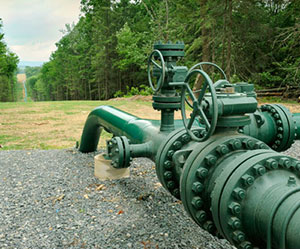
Photo Credit: Terry Wild Stock Photography, Williamsport, PA
Distribution Pipeline: A natural gas pipeline other than a gathering or transmission line (reference 49 CFR 192.3). A distribution pipeline is generally used to supply natural gas to the consumer and is found in a network of piping located downstream of a natural gas transmission line.
Easement: (1) A legal instrument giving a transmission pipeline operator a temporary or permanent right to use a right-of-way for the construction, operation, and maintenance of a pipeline. It may also include temporary permits, licenses, and other agreements allowing the use of one's property. (2) An easement is an acquired privilege or right, such as a right-of-way, afforded a person or company to make limited use of another person or company's real property. For example, the municipal water company may have an easement across your property for the purpose of installing and maintaining a water line. Similarly, oil and natural gas pipeline companies acquire easements from property owners to establish rights-of-way for construction, maintenance and operation of their pipelines. (3) A legal right, acquired from a property owner, to use a strip of land for installation, operation and maintenance of a transmission pipeline.
Emergency Preparedness: The act or state of being prepared to respond to and handle a pipeline emergency. Pipeline operators are required to have emergency preparedness programs, plans, and procedures in place to implement during pipeline emergencies.
Emergency Response: The actual response taken to address an emergency. The response to a pipeline emergency should be consistent with the pipeline operator's and other emergency responders' programs, plans, and procedures.
Encroachment: (1) A human activity, structure, facility, or other physical improvement that intrudes onto a transmission pipeline right-of-way. (2) Encroachment refers to the unauthorized use of a right-of-way in violation of the easement terms.
Excavation: Any operation using non-mechanical or mechanical equipment or explosives in the movement of earth, rock or other material below existing grade. This includes, but is not limited to, augering, blasting, boring, digging, ditching, dredging, drilling, driving-in, grading, plowing-in, pulling-in, ripping, scraping, trenching, and tunneling.
Excavator: Any person proposing to, or engaging in, excavation or demolition work for himself or for another person.
Facility Operator: Any person, utility, municipality, authority, political subdivision or other person or entity who operates or controls the operation of an underground line/facility.
Facility: A buried or aboveground conductor, pipe, or structure used to provide utility services, such as electricity, natural gas, liquids refined from oil, oil, telecommunications, water, sewerage, or storm water.
Gas: Natural gas, flammable gas, or gas which is toxic or corrosive. (Reference 49 CFR 192.3) Gases are normally compared to air in terms of density. The specific gravity of air is 1.0. Any gas with a specific gravity less than 1.0 (such as natural gas) will rise and usually disperse. Any gas having a specific gravity greater than 1.0 will fall and collect near the ground or in low-lying areas such as trenches, vaults, ditches, and bell holes - such occurrences can be hazardous to human health and safety.
Gas Transmission Pipeline: A pipeline, other than a gathering line, that 1) transports gas from a gathering line or storage facility to a distribution center, storage facility, or large-volume customer that is not downstream from a distribution center; 2) operates at a hoop stress of 20 percent or more of specified minimum yield strength; or, 3) transports gas within a storage field. (Reference 49 CFR 192.3) A gas transmission pipeline includes all parts of those physical facilities through which gas moves in transportation, including pipe, valves, and other appurtenance attached to pipe, compressor units, metering stations, regulator stations, delivery stations, holders, and fabricated assemblies.
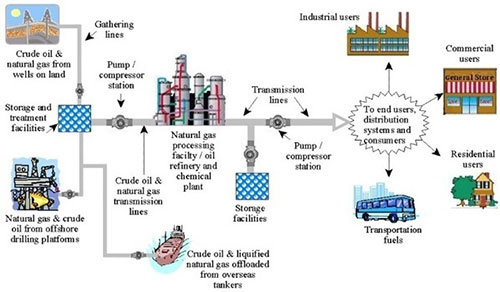
Geographic Information System (GIS): An organized collection of computer hardware, software, and geographic data used to capture, store, update, maintain, analyze, and display all forms of geographically referenced information.
Hazardous Liquid: Includes petroleum, petroleum products, anhydrous ammonia, and carbon dioxide. (Reference 49 CFR 195.2)
Hazardous Liquid Pipeline: All parts of a pipeline facility through which a hazardous liquids move in transportation, including, but not limited to, line pipe, valves, and other appurtenances connected to line pipe, pumping units, fabricated assemblies associated with pumping units, metering and delivery stations and fabricated assemblies therein, and breakout tanks.
High Consequence Area: A location that is specially defined in pipeline safety regulations as an area where pipeline releases could have greater consequences to health and safety or the environment. For oil pipelines, HCAs include high population areas, other population areas, commercially navigable waterways and areas unusually sensitive to environmental damage. Regulations require a pipeline operator to take specific steps to ensure the integrity of a pipeline for which a release could affect an HCA and, thereby, the protection of the HCA.
High-Priority Subsurface Installation: Sometimes referred to as high-priority underground installation, these include natural gas transmission pipelines operating at a pressure that creates a hoop stress of 20% or more of the steel specified minimum yield strength, hazardous liquid pipelines, high voltage electric supply lines, fiber optic lines, pressurized sewage pipelines, and other hazardous underground installations.
Horizontal Directional Drilling (HDD): Also known as directional boring, this is a method of installing pipes underground, where a hole is bored through a surface-launched drilling rig. HDD is used when open trench, open cut, or excavation is not practical, to avoid traffic disruption, or to cause less of an impact on environmentally sensitive areas, among other reasons. The process involves creating a receiving hole, where drilling fluid or mud (see Water Based Mud) lubricates the drill, and subsequently the pipe itself, through the desired arc.
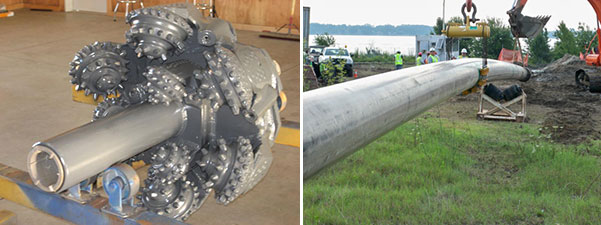

Incident: An unintentional release of product from a transmission pipeline that may or may not result in death, injury, or damage to property or the environment. (Note that as used in pipeline safety regulations, an "incident" is an event occurring on a natural gas pipeline for which the operator must make a report to PHMSA's Office of Pipeline Safety. Events of similar magnitude affecting hazardous liquid pipelines are considered "accidents". (Reference 49 CFR 191.3, 49 CFR 195.50)).
Integrity Management Program (IMP): "A documented set of policies, processes, and procedures that are implemented to ensure the integrity of a pipeline. Technically speaking: In accordance with pipeline safety regulations for oil pipelines, an operator's integrity management program must include, at a minimum, the following elements:
- a process for determining which pipeline segments could affect a High Consequence Area (HCA),
- a Baseline Assessment Plan,
- a process for continual integrity assessment and evaluation,
- an analytical process that integrates all available information about pipeline integrity and the consequences of a failure,
- repair criteria to address issues identified by the integrity assessment method and data analysis (the rule provides minimum repair criteria for certain, higher risk, features identified through internal inspection),
- a process to identify and evaluate preventive and mitigative measures to protect HCAs,
- methods to measure the integrity management program's effectiveness, and
- a process for review of integrity assessment results and data analysis by a qualified individual. (Reference 49CFR 195.452)"
Line pipe: The lengths of pipe comprising the main part of transmission pipeline segments, line pipe is identified as only the pipe, excluding ancillary facilities and structures that are located on company property adjacent to the pipeline ROW.
Liquefied Natural Gas (LNG): Natural gas that has been converted to a liquid form for ease and safety of non-pressurized storage or transport. Liquefied Natural Gas is not the same as a Natural Gas Liquid.
Liquid Petroleum Gases (LPG): A group of hydrocarbon gases, primarily propane, normal butane, and isobutene, which are derived from crude oil refining or natural gas processing. They can be liquefied through pressurization for transportation or storage.
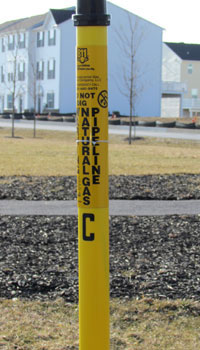 Locate: The process of determining the existence and location of an underground facility, such as an oil or gas pipeline. Following the locate, the surface of the ground above the underground installation is normally marked through the use of stakes, flags or paint, or in some other customary manner. Such markings identify the location of the underground facility so that excavators can avoid damage to the facility when digging.
Locate: The process of determining the existence and location of an underground facility, such as an oil or gas pipeline. Following the locate, the surface of the ground above the underground installation is normally marked through the use of stakes, flags or paint, or in some other customary manner. Such markings identify the location of the underground facility so that excavators can avoid damage to the facility when digging.
Locate Request: A communication between an excavator and one-call center personnel in which a notice of proposed excavation and request for locating underground facilities is processed. The one-call center subsequently passes this information to underground facility owners based on the location of the proposed excavation and underground facility data.
Mark: To indicate the existence and location of a line or facility by establishing a mark through the use of stakes, paint or some other customary manner.
Maximum Allowable Operating Pressure (MAOP): The maximum pressure at which a gas transmission pipeline or segment of a pipeline may be operated under federal pipeline safety regulations (29 CFR Part 192).
Mitigation: Actions taken to alleviate, reduce the severity of, or moderate the consequences of failure.
Natural Gas Liquids (NGL): Natural Gas Liquids belong to the same family of hydrocarbons as natural gas and crude oil, but are typically ethane, propane, butane and isobutene. Natural Gas Liquids are not the same as Liquefied Natural Gas. More Information
NPMS: National Pipeline Mapping System - a geographic information system (GIS) database that contains the locations and attributes of hazardous liquid and gas transmission pipelines operating in the United States. The NPMS also includes data on the locations of other geographic features throughout the U.S. The NPMS supports queries by the public and local governments to determine if transmission pipelines are located near their communities and to determine areas that could be impacted by releases from these pipelines. Visit Website
One-call Center: An entity that administers a one-call system through which a person can notify transmission pipeline operators of proposed excavations. Also known as 811.
 One-call System: A system that enables an excavator to communicate through a one-call center to transmission pipeline operators to provide notification of intent to excavate. The one-call center will gather information about the intended excavation and then issue tickets to notify affected member transmission pipeline operators. The operators can then clear the tickets or locate and mark the location of their pipelines before the excavation begins. Excavators can then take care when excavating to avoid damaging the transmission pipelines. All 50 states within the U.S. are covered by one-call systems. Most states have laws requiring the use of the one-call system at least 48 hours before beginning an excavation.
One-call System: A system that enables an excavator to communicate through a one-call center to transmission pipeline operators to provide notification of intent to excavate. The one-call center will gather information about the intended excavation and then issue tickets to notify affected member transmission pipeline operators. The operators can then clear the tickets or locate and mark the location of their pipelines before the excavation begins. Excavators can then take care when excavating to avoid damaging the transmission pipelines. All 50 states within the U.S. are covered by one-call systems. Most states have laws requiring the use of the one-call system at least 48 hours before beginning an excavation.
Open Season: The process by which an operator demonstrates the level of market interest for a project. It is typically run for 1-2 months, and allows potential investors an opportunity to enter into an agreement to sign up for a portion of the capacity rights that will be available. If enough interest is shown during the open season, the sponsors develop a preliminary project design and move forward. If not enough interest is evident, the project will most likely be dropped or placed on indefinite hold.
Ordinance: An authoritative public rule, law or regulation, such as a zoning ordinance, issued by a local community government. A zoning ordinance is a device of land use planning used by local governments to designate permitted uses of land based on mapped zones which separate one set of land uses from another. Zoning may be use-based (regulating the uses to which land may be put), or it may regulate building height, lot coverage, and similar characteristics, or some combination of these. See pipeline related ordinance examples on the Resources page.
Petroleum Products: Flammable, toxic, or corrosive products obtained from distilling and processing of crude oil, unfinished oils, natural gas liquids, blend stocks and other miscellaneous hydrocarbon compounds.
Pipeline: Used broadly, pipeline includes all parts of those physical facilities through which gas, hazardous liquid, or carbon dioxide moves in transportation.

Photo Credit: http://smartpigs.net
Pipeline Easement: See "Easement"
Pipeline Inspection Gauge (PIG): Devices that are used to perform various operations, such as cleaning or inspecting, in a pipeline without interrupting the flow of product in the line. The PIG's passage through the pipelines are monitored by GPS to provide location in both the pipe and geographically, the time in which it has passed through certain areas and find defects in the pipes for repair.
Pipeline Operator: For natural gas transmission pipelines, a person who engages in the transportation of gas (reference 49 CFR 192.3). For hazardous liquid pipelines, a person who owns or operates pipeline facilities (reference 49 CFR 195.2). Generally, an operator is a company or person responsible for the operation, maintenance and management of the transmission pipeline.
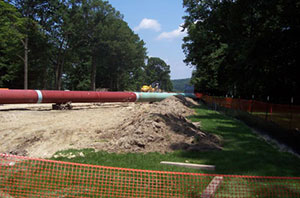
Photo Credit: Pipeline Safety Coalition
Pipeline Segment: A discrete portion of a transmission pipeline system as defined by the pipeline operator. A pipeline segment usually consists of a length of line pipe and may contain ancillary structures and other appurtenances associated with the pipeline. The end points defining the boundaries of a pipeline segment are usually determined by geographic features (e.g., mile posts) and/or features of the pipeline itself, such as welds, valves, etc.
Planning: An activity at the beginning of a project where information is gathered and decisions are made regarding the route or location of a proposed excavation based on constraints including the locations of existing facilities, anticipated conflicts and the relative costs of relocating existing facilities or more expensive construction for the proposed facility.
Planning Area: An area surrounding a transmission pipeline that is defined by ordinance and is based on characteristics of the pipeline and the area surrounding the pipeline. Local governments and property developers/owners should consider implementing a planning area to protect communities where new development is planned near transmission pipelines.
Plat: A map or representation on paper of a piece of land subdivided into lots, with streets, alleys, etc., usually drawn to a scale.
Potential Impact Radius (PIR): The radius of a circle within which the potential failure of a pipeline could have significant impact on people or property, as shown in the illustration above. For more information on the specific formula for determining the HCA see PHMSA's "HCA Identification FAQ-16". See also High Condequence Area page.
Project: An activity or task (or set of related activities or tasks) that is contemplated, devised, or planned and carried out for the purpose of accomplishing a goal. For example, a communication project could involve a planned set of activities to communicate the PIPA recommended practices to affected stakeholders. Usually thought of as affecting construction, maintenance or development activities, projects that could affect a transmission pipeline could be as simple as the planting of a tree or as complex as multi-million dollar construction projects.
 Right-of-way (ROW): (1) Property, usually consisting of a narrow, unobstructed strip or corridor of land of a specific width, which a pipeline company and the fee simple landowners have legal rights to use and occupy. A ROW is a string of contiguous properties on which easements have been acquired along which the pipeline operator has rights to construct, operate and maintain a pipeline. (2) A defined strip of land on which an operator has the right to construct, operate and maintain a pipeline. The operator may own a right-of-way outright or an easement may be acquired for specific use of the right-of-way. (Also see Rights-of-way.)
Right-of-way (ROW): (1) Property, usually consisting of a narrow, unobstructed strip or corridor of land of a specific width, which a pipeline company and the fee simple landowners have legal rights to use and occupy. A ROW is a string of contiguous properties on which easements have been acquired along which the pipeline operator has rights to construct, operate and maintain a pipeline. (2) A defined strip of land on which an operator has the right to construct, operate and maintain a pipeline. The operator may own a right-of-way outright or an easement may be acquired for specific use of the right-of-way. (Also see Rights-of-way.)
Right-of-Way Agreement: See "Easement"
Rights-of-Way: See "Right-of-Way"
Risk: the product of the probability or likelihood of an undesired event occurring and the consequences that may result from that event.
Risk Informed: Having adequate knowledge of associated risk to be able to make appropriate decisions relative to the risk.
Risk Reduction: Measures taken to minimize the probability or likelihood and/or consequences of risk.
Rural: An area outside the limits of any incorporated or unincorporated city, town, village, or any other designated residential or commercial area such as a subdivision, a business or shopping center, or community development. (Reference 49 CFR 195.2)
Setback: The minimum distance between a pipeline or the edge of a pipeline easement, and a building or other structure. A line established by local government ordinance, within a property, defining the minimum distance between any building or structure or portion thereof to be erected or altered, and an adjacent right-of-way, street or property line. The setback is usually expressed as the minimum distance between the line of demarcation (e.g., a pipeline or the edge of a pipeline easement) and a building or other structure.
Temporary Work Space: An area of land within which certain activities are authorized for a specified purpose and period of time, typically of short duration.Â
 Third-party Damage: Third-party damage includes outside force damage to underground facilities (e.g., transmission pipelines) that can occur during excavation activities and is caused by someone other than the facility operator or its contractors.
Third-party Damage: Third-party damage includes outside force damage to underground facilities (e.g., transmission pipelines) that can occur during excavation activities and is caused by someone other than the facility operator or its contractors.
Ton-miles: Describes the units of measure to measure the quantity and traffic of transportation used in transportation statistics, planning, and their related fields. A ton-mile is equivalent to moving one ton of freight product one mile.
Transmission Pipeline: When not specified includes both hazardous liquid and gas transmission pipelines. Transmission pipelines carry oil, petroleum products, natural gas, natural gas liquids, anhydrous ammonia and carbon dioxide from producing regions of the country to markets.
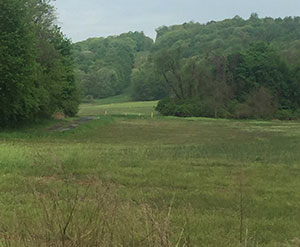 Transmission Pipeline Corridor: A pipeline corridor is a linear area where pipeline systems are closely grouped in a single right-of-way.
Transmission Pipeline Corridor: A pipeline corridor is a linear area where pipeline systems are closely grouped in a single right-of-way.
Urban: 1) Relating to or concerned with a city or densely populated area (e.g., "urban development"); 2) Located in or characteristic of a city or city life (e.g., "urban property owners").
Vapor Pressure: (also equilibrium vapor pressure) is the pressure of a vapor in thermodynamic equilibrium with its condensed phases in a closed container. Said another way, the vapor pressure of a liquid is the pressure exerted by its vapor when the liquid and vapor are in dynamic equilibrium. All liquids and solids have a tendency to evaporate into a gaseous form, and all gases have a tendency to condense back to their liquid or solid form. The equilibrium vapor pressure is an indication of a liquid's evaporation rate. It relates to the tendency of particles to escape from the liquid (or a solid). A substance with a high vapor pressure at normal temperatures is often referred to as volatile.
Water Based Mud (WBM): Horizontal directional drilling (HDD) is performed with a fluid known as drilling fluid, drilling mud, or water based mud (WBM). This fluid or mud is typically made of bentonite or polymer. WBM is pumped onto a drill or into the drill hole to facilitate the removal of cuttings, stabilize the drill hole, cool the drill head, and lubricate the passage of the pipe through the drilled hole. It is typically used for drilling boreholes for pipelines, oil and gas wells, and water wells.

Acronyms
811: Pennsylvania One Call/Call Before You Dig
ALTA: American Land Title Association
APGA: American Public Gas Association
API: American Petroleum Institute
APWA: American Public Works Association
BLM: U. S. Department of Interior, Bureau of Land Management
CFR: Code of Federal Regulations
DOT (or US DOT): United States Department of Transportation
Dth: Dekatherm
FERC: Federal Energy Regulatory Commission
HDD: Horizontal Directional Drilling
IMP: Integrity Management Program
INGAA: Interstate Natural Gas Association of America
MAOP: Maximum Allowable Operating Pressure
NACo: National Association of Counties
NAHB: National Association of Home Builders
NAR: National Association of Realtors
NARUC: National Association of Regulatory Utility Commissioners
NASFM: National Association of State Fire Marshals
NATaT: National Association of Towns and Townships
NFPA: National Fire Protection Association
NGL: Natural Gas Liquids
NPMS: National Pipeline Mapping System
NTSB: National Transportation Safety Board
NPDES: National Pollutant Discharge Elimination System
OPS: US DOT Office of Pipeline Safety
PA DEP: Pennsylvania Department of Environmental Protection
PA DOT: Pennsylvania Department of Transportation
PA PUC: Pennsylvania Public Utilities Commission
PEMA: Pennsylvania Emergency Management Agency
PHMSA: Pipeline and Hazardous Materials Safety Administration, U. S. Department of Transportation
PIG: Pipeline Inspection Gauge
PIPA: Pipelines and Informed Planning Alliance
PSI: Pounds per Square Inch
PSC: Pipeline Safety Coalition
ROW: Right-of-Way (or, Rights-of-Way)
WBM: Water Based Mud


